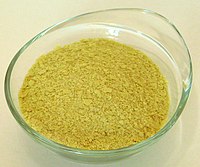
Photo from wikipedia
An unnatural flavor in a food or drink product caused by the presence of undesirable compounds due to contamination or deterioration is called off-flavor. This study determined the characteristics of… Click to show full abstract
An unnatural flavor in a food or drink product caused by the presence of undesirable compounds due to contamination or deterioration is called off-flavor. This study determined the characteristics of cattle by-products off-flavor (heart, liver, lung, rumen, and intestine). We identified 25, 34, 26, 22, and 26 volatile compounds from the heart, liver, lung, rumen, and intestine, respectively, in the bovine via headspace solid-phase microextraction/gas chromatography-mass spectrometry (HS-SPME/GC-MS). Based on the relative odor activity value (ROAV ≥ 1), 16 volatile compounds were labeled as characteristic off-flavor by principal component analysis (PCA) and partial least squares-discriminant analysis (PLS-DA). The compounds involved in the characteristic off-flavor in bovine heart were E,E-2,4-nonadienal, E,E-2,4-decadien-1-al, hexanal, (E)-2-octenal, and decyl aldehyde. In the bovine liver, the off-flavor compounds were 1-nonanol, ethyl hexanoate, 2-octanone, and dodecyl aldehyde and in bovine lung 3-heptylacrolein was the off-flavor compound. In bovine rumen, heptaldehyde, octanal, p-cresol, and 1-nonanal were off-flavor compounds, and lastly, 1-octen-3-ol and E-2-nonenal were off-flavor compounds with bovine intestine. The cattle by-products were deodorized by shallot-ginger extract masking, baker's yeast fermentation, active dry yeast + β-cyclodextrin (β-CD) composite, and ultrasound + chitosan composite. The above 16 labeled characteristic compounds decreased in concentration. The ultrasound + chitosan composite method showed a significantly better effect than the other methods (p < .05). The aim of this study was to determine the characteristic flavor information of cattle by-products and provide idea on how to improve the flavor by various deodorization methods. PRACTICAL APPLICATIONS: This study investigated the volatile flavor compounds of cattle by-products from five organs (heart, liver, lung, rumen, and intestine) by headspace solid-phase microextraction/gas chromatography-mass spectrometry (HS-SPME/GC-MS). The 16 volatile compounds were labeled as the major characteristic off-flavor compounds by relative odor activity values and principal component analysis. Four different deodorization methods were adopted, and among them, ultrasound + chitosan composite method showed best results. This study has provided useful information about the characteristic off-flavor compounds and suggests how to improve the flavor of cattle by-products through various deodorization methods.
Journal Title: Journal of food biochemistry
Year Published: 2022
Link to full text (if available)
Share on Social Media: Sign Up to like & get
recommendations!